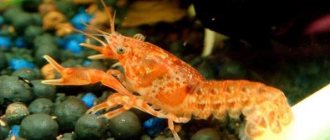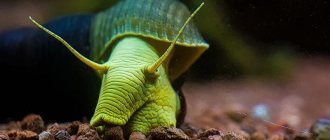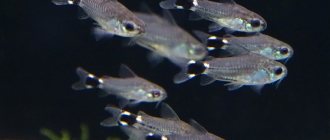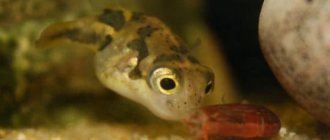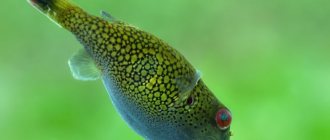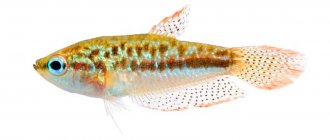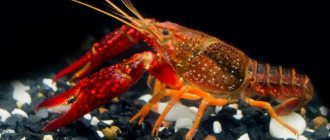author: fisher 01/18/2018 0 Comments
Freshwater crustaceans
invertebrates
The orange dwarf crayfish (Cambarellus patzcuarensis) is a small, brightly colored creature, usually no more than five centimeters in size.
The habitat of this crayfish is limited to the relatively small alpine lake Patzcuro (Mexico) (20×14 km with a maximum depth of 50 m), located in the crater of an extinct volcano, at an altitude of 2200 meters above sea level and mountain streams running along the slopes of the same mountain ranges.
Crayfish stay close to the shore, hiding in fallen leaves. Unlike their other relatives, orange dwarfs are also active during the daytime, when they are busy searching for food.
As for taxonomy, all dwarf crayfish belong to the genus Cambarellus, which currently numbers about twenty species. Almost all of them, with rare exceptions, have a very modest appearance, which is why they do not receive much attention from aquarists.
Orange dwarf crayfish
This dwarf crayfish was first described in 1943 by the famous decapod specialist Alejandro Villalobos. The orange dwarf crayfish found in hobbyist aquariums is actually a color morph of the dull-colored wild species.
Wild cambarellus are colored rather modestly, in the colors of a yellow-brown palette. Thanks to this coloring, they are almost invisible on the bottom of the lake covered with fallen leaves.
As for the bright orange color of crayfish, expert opinions differ: some consider it the result of natural mutations, others claim that this is the result of the work of breeders, while most prefer the “hybrid” option: when the bright color of mutants taken from nature is artificially fixed in aquarium conditions.
In nature, bright orange individuals do not live long; they are the first to fall into the mouths of predators. But such a color morph can be preserved and multiplied in an aquarium.
This brightly colored form was obtained in Holland through artificial selection.
It is interesting that another Mexican alpine lake of volcanic origin, Cempoala, is inhabited by another dwarf crayfish (Cambarellus zempoalensis) with a similar appearance, described in the same year and by the same Alejandro Villalobos.
It differs from its counterpart from Patzcuaro by clear brown-reddish longitudinal stripes running from head to tail.
In the catalogs of exporting companies, the orange dwarf crayfish appears as Cambarellus patzcuarensis var. “Orange”, abbreviated as SRO.
the size of orange dwarf crayfish usually does not exceed five centimeters
Quite often, in one batch of crayfish supplied to the retail chain from exporting companies, there are individuals with both even colors and “striped” ones. And in litters obtained from one female, you can find both the former and the latter. In addition, the nuances of the color of crustaceans are often determined by the environment, the quality of water and food supply.
The option of interspecific crossings (including spontaneous ones) within the genus Cambarellus with the production of offspring capable of reproduction cannot be ignored.
With the exception of the exterior, the above-mentioned crayfish are no different: they have the same size (no more than 5 cm, males have a maximum of 4) and have the same requirements for conditions of detention and reproduction.
In Europe, orange dwarfs appeared at the very beginning of the 21st century, and after some time they appeared in Russia.
The orange dwarf crayfish appealed to both domestic and foreign aquarists.
Keeping orange dwarf crayfish in an aquarium
The anatomy of crustaceans is radically different from the anatomy of fish. Knowing the names of the numerous organs that make up crayfish is not necessary for most aquarists.
It is much more important to create living conditions acceptable to them.
This is not at all difficult to do and there is minimal hassle with dwarf crayfish . They are very unpretentious creatures, flexible and have a good supply of vitality.
Orange dwarf crayfish
Creating an acceptable habitat is unlikely to cause difficulties even for a novice aquarist: pH 7.0 - 8.5, total hardness 10-20dGH, water temperature from 18 to 26°C. In most cases, these indicators correspond to water flowing from a water tap.
The light regime, plant content, type of soil do not matter, it is only important that in one form or another all this is present in the aquarium.
Crayfish do not require special care. Everything is standard: soil siphon, aeration, filtration.
Cambarellus can hardly be called mobile creatures. They come to life only when hungry and during the rutting season.
During molting, all crustaceans need secluded places where they can hide from predators, and at the same time grow a little until their new shell gains sufficient rigidity.
During this period, they are very vulnerable and can be of gastronomic interest not only for fish, but also for other larger crayfish.
Shelters can be grottoes made of natural and artificial stone, small ceramic containers, coconut shells, etc., with an inlet diameter of 2 cm.
Unlike natural, plastic grottoes with a smooth inner surface, crayfish are usually ignored. To use such products, it is necessary to cut off their bottom or roughen it with sandpaper.
Having chosen one of these places, the crayfish often blocks its entrance, raking up the soil with its claws like a snowblower. If it is necessary to leave its shelter, the cancer clears away the rubble, and when it returns, it restores it again.
An excess of nitrogen compounds in water and a lack of calcium should not be allowed. Both of these factors make molting difficult, which ultimately leads to troubles for crayfish, in the form of underdeveloped limbs, and sometimes death.
After all, for crustaceans, changing their shell is the only way to grow up and acquire more spacious clothing.
There is a definite relationship between changing the water in the aquarium and molting.
It is enough to replace part of the water in the aquarium and in a day or two the crayfish will shed their old shells.
We should not forget that molting for crustaceans is also a way to restore lost limbs. Therefore, at the slightest threat to life, they easily part with them in order to return the loss after some time. Most often, the claws are lost, as the main grasping tool and a tool for internal disassembly. But the remaining limbs may suffer the same fate.
The more places in the aquarium where crayfish could hide, the more confident they feel in it, but the less often they can be seen.
The best hiding places for crayfish are a variety of tunnels, as there is always a way to escape.
Orange dwarf crayfish look beautiful against the background of green plants
To create ideal conditions for observing dwarf crayfish , a small group of 5-6 crayfish should be placed in a separate container, at the rate of 6-8 liters of water and 1-2 shelters for each individual.
The best option can be considered an aquarium with a low water level (15-20 cm), dark soil, medium fraction, moderately planted with rosette plants (crayfish are more noticeable in thickets of such plants). Moreover, preference should be given to containers with a larger bottom area, as this will increase the living space for its inhabitants and will contribute to better mixing of water when using a microcompressor or a small airlift filter, since crustaceans do not tolerate a deficiency of oxygen dissolved in water.
In the summer season, the water temperature should be monitored and, if possible, not allowed to increase above 28°C; when approaching the critical point, air flow should be increased.
It is recommended to periodically monitor the general hardness of the water in the aquarium and, if necessary, increase it using solutions of calcium chloride and magnesium sulfate.
The orange dwarf crayfish is a fairly harmless creature. Most conflicts that arise within a group are caused by a lack of space and a lack of shelter. If everything is fine with this, then fights are rare and non-traumatic.
Sometimes males show aggression, but only towards each other. In most cases, a weaker cancer will always yield to an opponent superior in strength not only to the road, but also to its prey.
The relationships between orange dwarfs and fish are rather ambiguous. Since crayfish themselves are not known for their courage and shy away from the slightest shadow. Even representatives of such small species as guppies or neons are able to drive crayfish into a shelter.
At the same time, dwarfs are quite capable of fending for themselves and even attacking relatively large fish encroaching on their food. However, such attacks, as a rule, are limited to only militant clicking of claws.
Even after many months, Cambarelluses are unable to distinguish true from imaginary danger.
Dwarf orange crayfish have not been observed damaging living plants or digging in the soil. So they can find a place in the herbalist.
Crayfish plants are used only as beds. Their favorite pastime is to climb on top of plants and sit comfortably on them with their claws hanging down. They can remain in this position for quite a long time.
They do not pose a threat to mollusks, although they are very interested in them. Moreover, this interest is caused not by the gastropods themselves, but by the products of their vital activity and various microorganisms living on the surface of the shells.
Juvenile crayfish show a particular predilection for this, so the presence of various types of fish and coils in a growing aquarium is welcome.
But they catch young shrimp and eat them with pleasure. Therefore, if the goal is to breed shrimp, you should not add these crayfish to them.
Dwarf crayfish can be depressed by the presence of other “cave creatures” such as badis in the aquarium. The proximity to many cichlids is also far from ideal.
At the same time, crayfish practically do not have quarrels with other benthic inhabitants of the aquarium, such as acanthophthalmus, corydoras, small ancistrus, gobies and loaches, especially with an excess of shelters.
Orange dwarf crayfish with small and medium-sized fish ; they do not even attack guppy fry, but at the same time, sometimes they are not averse to feasting on fish eggs and newly hatched larvae.
But large fish can pose a threat to the diapods themselves.
It is not recommended to keep dwarf orange crayfish with other representatives of the genus Cambarellus in order to exclude the possibility of interspecific crossing.
In general, dwarf crayfish are flexible animals, they quickly get accustomed to a new aquarium, and easily adapt to changing conditions, although they prefer to do without radical changes. Thus, adult specimens can easily tolerate an almost complete change of water in the aquarium, which cannot be said about newborn crustaceans; in such a situation they may die.
Under favorable conditions, the orange dwarf crayfish can live for about two years.
Genus Cambarellus.
Dwarf crayfish are members of the Cambarellus family. They are distributed in the United States along the Mississippi River and in Mexico. The smallest representatives of this group grow up to 3 cm long, the largest up to 4.5 cm. Dwarf crayfish get along well with the population of the aquarium without interfering with the surrounding life. They are especially friendly towards small, peace-loving fish that live in the middle and upper layers of water. It is necessary to avoid settling dwarf shrimps with them. Cancers can attack them. At the same time, severed limbs are not the worst thing that can happen to shrimp. If a crayfish manages to grab a shrimp, it becomes a pleasant treat for him and adds variety to his menu. All species belonging to the Cambarellus family have different temperaments. In a well-structured aquarium with plenty of hiding places, Louisiana dwarf crayfish and swamp dwarf crayfish coexist perfectly, and they do not have problems with offspring. But spotted leopard geckos and yellow Mexican crayfish attack not only their relatives, but also eat their own offspring. All Cambarellus species can be propagated without any difficulty. Females lay offspring three to four times a year. When 10 (Louisiana dwarf crayfish) and more than 100 (swamp dwarf crayfish) eggs are laid, the number of crayfish gradually increases. Obtaining offspring is necessary to maintain the population of crayfish in the aquarium, since the life expectancy of this group of crayfish varies from 14 to 30 months depending on the species.
Cambarellus patzcuarensis sp. Orange Dwarf orange crayfish.
Distribution: wild form - Mexico. Dimensions: Females 40-50 mm in length, males smaller Contents: Temperature 22-255C, dGH 8, pH 7.0-8.0. It is a close relative of Cambarellus montezumae. In nature, Cambarellus patzcuarensis sp. Orange has a light brown color, matching the bottom, consisting of brown fallen leaves, and only two dark stripes on the tail. And their bright shades of yellow and orange were bred artificially. They need strong aeration at temperatures above 25 degrees in summer.
Cambarellus diminutus
Cambarellus diminutus
Habitat: North America Dimensions: 2.5 cm. Contents: Temperature 15-27SC, dH 5-10°, pH 6.5-7.8 One of the smallest crayfish. Brown-greenish marbled. An aquarium, for maintenance, is desirable to be at least fifty centimeters in length, with a lot of snags and stones dividing the bottom of the area. It is necessary to create shelters and shelters. Weekly 25% water changes are required. Can be kept with small, non-aggressive fish; interspecific aggression is weak.
Cambarellus puer Swamp dwarf crayfish.
Cambarellus puer Swamp dwarf crayfish
Habitat: North America Dimensions: 3 cm. Contents: Temperature 15-27SC, dH 5-10°, pH 6.5-7.8 Reddish-brown to gray in color, with paired dark, wavy stripes or a dotted line along the dorsal surface. The tail usually has a dark spot in the center. Their pincers are narrow and long.
Cambarellus shufeldtii Louisiana dwarf crayfish.
Cambarellus shufeldtii Louisiana dwarf crayfish
Habitat: North America Dimensions: 3 cm. Contents: Temperature 20-25sC, dH 5-10°, pH 6.5-7 Shelters in driftwood or stones must have a minimum diameter of 15 mm and a depth of at least 4 cm, otherwise they will will not be used.
Cambarellus montezumae Mexican dwarf crayfish. Stream crayfish, Spotted gecko .
Cambarellus montezumae Mexican dwarf crayfish.
Habitat: Mexico Dimensions: up to 6 cm Contents: Temperature 15-30C, dGH 8, pH 6.4-8.2. A close relative of Cambarellus patzcuarensis, this is one of the dwarf crayfish, their homeland is Mexico. The juvenile or after molting may look different and be striped, but the adult will look like the photo. During the first few months after a crayfish is born, most babies are a very light brown color. These crayfish do not spoil plants. They can easily fight among themselves, like all crayfish. They love shelters. They eat bloodworms, shrimp food, peeled shrimp, tubifex, and eat dead fish. Can interbreed with other species like Cambarellus patzcuarensis Life expectancy is about 18 months.
Diet of orange dwarf crayfish
with feeding dwarf crayfish : they graze on their own and eat almost everything, so you can safely leave the decapods for a couple of weeks without worrying about their health: you don’t even need an automatic feeder - the dwarfs will find something to eat without it. The materials used are decaying parts of plants, benthic microorganisms, dead animals, and even waste products of fish and shellfish.
As for targeted feeding, any traditional fish food is suitable for this purpose: live and frozen insect larvae, crustaceans, tubifex, etc. Dry flakes and granules (including those with plant components) will also not be superfluous.
To this standard menu you can add green peas, low-fat cottage cheese (preferably grained), small pieces of omelet (cooked without oil or in the microwave), minced shrimp and other seafood, and poultry fillets.
Preference should be given to quickly sinking feed, since otherwise the main part of the feed does not have time to reach the recipients. In this case, it is necessary to maintain proportionality in portions and use products that minimally spoil the water.
Juvenile orange crayfish happily eat small shrimp, various types of flakes and granules. Juvenile dwarf crayfish, like many others, require food rich in protein, such as the meat of sea fish and shrimp, bloodworms, etc. They also need food of plant origin. If you believe some publications, the share of plant foods may account for about half of the diet.
If you add discarded heterosexual shrimp to an aquarium with orange dwarf crayfish , the crayfish will be able to feed on their young from time to time.
Again, fish eggs and sedentary juveniles will not go unnoticed by the crayfish.
True, only hunger can motivate orange dwarfs to actively hunt, and without compelling reasons, hunting for healthy fry is too tiring for decapods.
The shells shed during molting will also be used, so you should not remove them from the aquarium - they are a valuable source of calcium - the basis for building a new shell.
Some specialized feeds, in particular those enriched with carbonates, are also useful.
Genus Procambarus - Procambarus.
Red swamp, Florida or Vietnamese crayfish. They inhabit water bodies in the southern part of North America. 10-12 cm. These crayfish are popular in aquariums around the world due to their magnificent coloring. Unlike Russian crayfish, which turn red only during the cooking process, these ones already have bright outfits during life. The color of an adult crayfish is usually red-brown with bright red spots on the claws. The color of crayfish varies slightly depending on the conditions of detention, and most importantly, on the diet (from bluish-violet to dark brown). Thus, when using food rich in carotenoids, red colors predominate in the color of Florida crayfish. When there is a shortage of sources of red pigments in the menu, the color of decapods shifts towards brown tones, and when feeding, for example, on mussels, the color of crayfish is dominated by light blue or even blue shades. There are no Florida crayfish that are completely red. As a rule, this color applies only to their claws and part of their legs. But in individuals fed on mussels, blue color prevails in almost all areas. The cephalothorax of crayfish is dark. Red-colored specimens have whitish spines scattered throughout the body and claws; in blue-colored ones they are yellow. By the way, the color of crayfish changes precisely during molting. It happens that a lack or accumulation of nutrients gives an unusual effect. Thus, the bright blue Florida crayfish, after molting, becomes greenish-brown. Or, on the contrary, a grayish-brown individual begins to shine in new red clothes. In this way, you can predetermine the future color of your pets and get individuals of the same species painted in different colors. To do this, some crayfish need only pieces of shrimp or carrots, others need chopped mussels and scallops, and others need lean fish or squid. Or you can accustom your pets to dry food with red color stimulants, and then they will all be colored in one very attractive color scheme.
Procambarus acanthophorus
Procambarus acanthophorus
Area: Mexico. Dimensions: up to 10 cm. Contents: Temperature 20-28°C: dH wide range, pH wide range. How to distinguish a male from a female: As usual (more powerful claws, gonopodium in males, wider tail in females). requires plenty of hiding places and good bottom area (as with all crayfish!)
Procambarus cubensis Blue Cuban crayfish.
Procambarus cubensis Blue Cuban crayfish.
Location: Cuba. Dimensions: 10-12cm. Contents: Temperature 20-26sC, dH 10-20% pH 7-8. Blue Cuban crayfish is unpretentious in captivity and easy to keep. They are kept in common decorative aquariums, covered with a lid on top, otherwise the crayfish will escape. The water level is 4-5 cm below the edge of the aquarium. Volume from 100 l. For six adults, a volume of 120 liters is sufficient. The substrate is sand, preferably with marble or limestone chips. The duration of daylight in summer is 10-12 hours, in winter - 8-10. The Blue Cuban Crayfish likes to climb and hang on to plants. The most suitable: Cryptocoryne usteriana and Thai fern (Microsorium pteropus). You need shelter: driftwood, stones, plants, flower pots, ceramic tubes, anything that creates shelter. They are fed dry fish food (flakes), mosquito larvae, daphnia, gammarus, bloodworms, fallen leaves, earthworms, greens (spinach), and fresh vegetables. Keeping them with bottom-dwelling fish is not advisable, as crayfish can seriously injure them!
Procambarus clarkii Red swamp, Florida or Vietnamese crayfish.
Procambarus clarkii
Area: USA Dimensions: 10-12 cm. Contents: Temperature 22-26 C, dH wide range, pH wide range. They are practically omnivorous: they pounce on pieces of shrimp or carrots with equal passion, do not refuse lean fish, meat, hearts, squid, lettuce, and actively react to traditional live aquarium food - bloodworms, coretra and tubifex. Decapods have an excellent appetite, and the main thing here is not to overdo it. As soon as you notice that your pets no longer pounce on food so greedily, it is better to remove the remaining food from the aquarium. You need a separate aquarium with driftwood, rock shelters, and artificial plants. Cancers need shelter. When several individuals are kept together, the lack of a sufficient number of shelters will lead to conflicts. Often, a wildlife lover wants to keep crayfish in an aquarium with fish. We can say that under certain conditions this is possible. Well-fed crayfish do not catch moving and non-bottom fish, and large specimens do not attract their attention. Hungry crayfish is also an unimportant neighbor for small and medium-sized fish.
Procambarus Clarkii sp. White Florida crayfish.
Procambarus Clarkii sp. White Florida crayfish.
Area: USA Dimensions: 12cm Contents: Temperature 22-26 C, dH wide range, pH wide range. Can be kept in aquariums with a bottom area of 100cm x 40cm. Behavior: Like most crayfish, they are omnivores and will eat your plants. In an aquarium, to support several individuals, there must be enough bottom area and shelters; in large numbers, they self-regulate during molting. The wild color is mostly red; selected species may have white, blue, or orange color options.
Procambarus sp. "marble crayfish" Marble crayfish.
Procambarus sp. "marble crayfish" Marble crayfish.
Area: USA Dimensions: 8 cm. Contents: Temperature 22-26 C, dH wide range, pH wide range. Since the Marbled Crayfish is a selection of Procambarus clarkii, their keeping conditions are the same.
Procambarus spiculifer
Procambarus spiculifer
Area: USA Dimensions: 12 cm. Contents: Temperature 22-26 C, dH wide range, pH wide range. Although Procambarus spiculifer can be kept in water of varying hardness and acidity, they still prefer softer and more acidic water, and are more critical of water purity than other Procambarus species. The main diet is plant foods.
Procambarus Allenii Florida blue crayfish.
Procambarus Allenii Florida blue crayfish.
Area: USA Dimensions: up to 10 cm. Contents: Temperature 22-26 C, dH wide range, pH wide range. Behavior: Like most crayfish, they are omnivores and will eat your plants. In an aquarium, to support several individuals, there must be enough bottom area and shelters; in large numbers, they self-regulate during molting.
Breeding orange dwarf crayfish in an aquarium
Breeding dwarf crayfish is a fairly simple process and is accessible even to a beginner. This will not require creating any special conditions; there will be no need to stimulate this process. The only thing you can’t do without is periodic water changes.
Dwarf crayfish sexually mature early - at the age of 3.5 - 4 months. At a length of two centimeters, they can already reproduce. A couple most often forms spontaneously. To do this, it is advisable to have a group of different-sex cancers so that they have the opportunity to find the most worthy partner at the moment.
For breeding dwarf orange crayfish , a container with a volume of about 30 liters is suitable, the bottom of which is covered with pre-scalded, or even better, boiled oak leaves for 3 minutes, which should be replaced with new ones every next two weeks. Instead of oak leaves, you can use sea almond leaves.
For breeding, one male and two or three females are placed in a spawning tank, and in order to avoid inbreeding, producers should be taken from different litters. If this is not done, the crayfish will degenerate over time, which is manifested in a paler color and small size.
Fertilization in crayfish is external and usually occurs after molting. Mating lasts only a few minutes until the female frees herself from the male's embrace. The latter sticks its spermatophores on the underside of the female's cephalothorax, which look like a white spot.
Newborn crustaceans are a greatly reduced copy of their parents, only less bright
The female usually lays eggs at night, the whole process takes about 2-3 hours. By bending the abdomen towards the cephalothorax, so as to form a chamber into which the female releases a special substance that dissolves spermatophores with sperm attached to the cephalothorax. The eggs, emerging from the oviduct, pass through this seminal solution, in which they are fertilized, and then attach to the abdominal legs or shell.
The fertility of females depends on a number of factors, such as size, physical condition, season, etc. There can be up to 60 eggs on the legs at the same time, usually 20-30. The eggs are large, opaque, from grayish-greenish to dark green, almost black. It is impossible not to notice them.
During this period, the already cautious female becomes hyper-fearful; almost the entire time of incubation she is in a shelter, which she leaves only in case of urgent need.
You should not take eggs from the female. Since it constantly ventilates the masonry with its swimming legs, at the same time cleaning the shells of the eggs from debris, and perhaps also secretes a special secretion that has fungicidal properties.
At first, the caviar is painted almost black, which lightens over time, becoming white with a black dot. Orange color indicates that the egg is not fertilized.
Incubation time depends on several factors, the main ones being water temperature and its chemical composition. At a temperature of 24–26°C, embryo development lasts on average 12–14 days; at a water temperature of 21–24°C, the larvae hatch on the 16th day.
During the first 2-3 days they hang on the so-called hyaline threads, after which they break, young crustaceans are attached to the shell of the eggs using small backward-curved hooks on the claws. They stay in this state for 5-8 days, feeding only on the yolk reserves, which are located under the dorsal shell of the cephalothorax.
Newborn crustaceans are a greatly reduced copy of their parents, only less bright. All that is required is to provide them with appropriate care, which consists of feeding and changing water.
Over the next ten days, the first moult occurs, after which the newborns become similar to adult crayfish.
After the second molt, which usually occurs on days 14-20, the crustaceans grow noticeably. During life, molting in crayfish is repeated many times: in the first year - 8 times, in the second - 4-5 times.
Juveniles have very good health and under optimal conditions their mortality is minimal (no more than 5-10%).
By the fifth week, juvenile dwarf crayfish are practically no different in color from adults. During this period, water parameters are of great importance. Winter temperatures should be between 20–21°C, and summer temperatures 22–25°C, with a pH value of 8.0 units.
Water changes should continue, 25% of the total volume, every 3-4 days.
The first 1.5 months are the most dangerous period in the life of young crustaceans: during this period they are especially susceptible to diseases, in addition, they can be eaten by fish and larger fellow tribesmen.
For the first two weeks, it is recommended to use any “baby” food such as sera vipagran. Then, as they grow, their diet is expanded, including scraped bloodworms, chopped tubifex, etc. It is advisable to include frozen crustaceans in the menu. Their meat is rich in protein and minerals, and the chitinous shell will allow young crayfish to replenish calcium reserves. Dead crayfish are not removed - their muscles and skeletal tissues will serve as good food for their fellow tribesmen.
Rich pastures for young animals are thickets of mosses and airlift sponge, on the surfaces of which all kinds of edible debris and microorganisms collect.
Molting of young crayfish and waiting out the “soft” phase occurs in plant thickets. But, despite frequent molting, the juveniles grow very slowly.
As mentioned above, juveniles do not like sharp fluctuations in water parameters, so it is better to change the water more often, but in small portions.
If possible - 3-4 times a week for 10% (at least at first). After a month, you can switch to the usual scheme: 15–20% weekly.
In general, there is little dirt from crayfish, and its main source is leftover food, so it is important to choose the right dose. This will avoid problems with water quality.
Cannibalism occurs among crayfish due to a group lifestyle, frequent molting and uneven growth. Large individuals eat smaller and weaker ones.
After only 4–5 weeks, the female is again ready to bear offspring. It is advisable to plant the first brood by this time.
A female can be fertilized 4-5 times throughout her life.
Appearance and gender differences
Mandarin crayfish are descendants of ordinary gray crayfish. The patzcuaro crayfish acquired its rich orange color as a result of painstaking selective selection. The shells of this species have spots and
lobar stripes of darker shades of orange. Adults are very modest in size, hence the name “dwarf”. In its natural habitat, the female tangerine crayfish reaches only 6 cm in length, and the male is even smaller - 4–4.5 cm. But despite this, males have more powerful elongated claws, reminiscent of a lancet, which gives them the opportunity to defend themselves well in duels. The claws of females, on the contrary, are more miniature. The lifespan of Patzcuaro crayfish is approximately two years.
Diseases of dwarf crayfish
Cancers, just like all other animals, get sick. They are most often affected by plague and rusty spot disease. And various parasites can find shelter on the shell of crayfish. Crayfish are treated in the same way as shrimp.
Proven product ECTOL CRYSTAL JBL ET ECTOPUR SERA in an amount of 6-8 or more teaspoons of powder diluted in water per 10 liters of water. Pour 100 ml every half hour throughout the day. In a day, all parasites will die. This procedure does not affect shrimp and crayfish. You should not be afraid of an overdose. The procedure is repeated a week after replacing the water and soil siphon.
Description
Adults reach a length of only 3-4 cm and are comparable in size to dwarf shrimp such as Crystals and Neocardines.
This cancer has many beautiful curved, wavy and dotted lines. The abdomen has a pale olive base color with a pattern of a wide light stripe with a dark edge.
There is a clearly visible dark spot in the center of the tail. Tiny dots are visible throughout the body and form many patterns and color variations.
The painted crayfish has graceful elongated and narrow claws.
Life expectancy is 1.5–2 years, but under optimal conditions they are known to live even a little longer.
Shedding occurs regularly. Adult crayfish change their old shell up to 5 times a year, while juveniles replace it every 7–10 days. During this period, they hide in shelters until the body covers harden again.
Epilogue
The orange dwarf crayfish (Cambarellus patzcuarensis) is a rather unusual addition to the population of almost any home aquarium. And of course, exoticism against the backdrop of some satiety of the aquarium community with fish. In general, there is a minimum of hassle with cambarellus, and they bring significant variety to the life of the aquarium.
It's a shame that these amazing creatures don't live long. So, if you intend to keep dwarf crayfish for a long time, then in order to preserve the aquarium population you will have to take care of their breeding.
Breeding
By three months, Patzcuaro crayfish reach sexual maturity, provided they have reached 15–20 mm in length. By observing the conditions of detention, you can count on the fact that in the near future your pets will have numerous offspring. During the spawning period, crayfish should be fed with beech and oak leaves and alder fruits. Newly born crustaceans reach about 4 mm in length. They like to hide in secluded places, such as under the roots of plants or between their leaves, which is why they can be so difficult for an outside observer to notice.
Reproduction and breeding
In an aquarium where there are no pronounced seasonal changes in the habitat, crayfish themselves determine the onset of the breeding season.
Females carry the clutch with them under their abdomen. In total, a clutch can contain from 10 to 50 eggs. The incubation period lasts 3 to 4 weeks depending on water temperature.
After hatching, the juveniles continue to remain on the female’s body for some time (sometimes up to two weeks). Instincts force the female to protect her offspring, and the juveniles to stay close to her for the first time. However, when the instinct weakens, she will certainly eat her own offspring. In the wild, by this time young crayfish have time to travel considerable distances, but in a closed aquarium they will have nowhere to hide. Until the moment of birth, the female with eggs should be placed in a separate tank, and then returned back when the young become independent.
